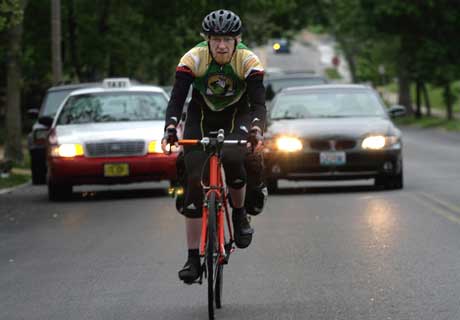
Gas prices are speeding toward $4 a gallon. Motorists are uneasy about America's dependence on foreign oil. The push is on to reduce carbon emissions. And obesity is epidemic.
Despite all that, Missouri lags behind the rest of the nation when it comes to cycling and walking as a means of commuting.
The Missouri Bicycle Federation has released its first annual "Bicycling and Walking in Missouri — A Report Card" just in time for National Bike to Work Week. It gave Missouri a "D".
David Henline, an avid cyclist, says that seems harsh where St. Louis is concerned.
"I think St. Louis is a good place to ride a bike," says Henline, 38, of Maplewood. "I feel very safe. But it's probably because I'm educated (about cycling), and I live in an inner-ring suburb where there are lots of routes and sidewalks for pedestrians. I'd give St. Louis a C+."
For the past four years, rain or shine, Henline, 38, of Maplewood, has made the 42-mile, round-trip commute to his job as an art director at Dent Wizard in Earth City by riding his bike and MetroLink. Part of his cycling is along bike routes, but much of it is not.
Todd Antoine, deputy director for planning at the Great Rivers Greenway District, agrees with Henline's assessment. The district collects 1/10th of 1 percent of local sales taxes to fund cycling projects.
"When looking at the whole state, you're looking at small towns and rural areas that don't have the resources to develop trails and networks," Antoine said. "But we're seeing a change in thinking from MoDOT, St. Louis County Highways Department and local municipalities. They're looking at simple design changes that allow cyclists to feel safe riding on the side of road. So there's definitely growing support."
The near-flunking grade was news to him. A day after the report was released The Great Rivers Greenway District, Trailnet and Bike St. Louis, in a coordinated effort, opened three new on-street bike routes in Maplewood, Clayton and north St. Louis.
The routes, which cost about $580,000, were Phase 2 of the Bike St. Louis project. They expand on the 20 miles built during Phase 1. The 77 miles of bicycle routes snake through nearly every neighborhood of the city of St. Louis and link up with MetroLink stops and regional trails.
Later this year, they'll add another route that runs from the Grant's Trail trailhead through Kirkwood to its community center.
The cycling organizations are also kicking off a public awareness campaign, which will include putting posters in 40 MetroBus shelters and 10 MetroLink stations. Their websites also list dozens of events and educational programs.
BY THE NUMBERS
The Missouri Bicycling Federation's 23-page report card looks at 40 criteria such as the number of injuries incurred by cyclists and pedestrians; number of cities with cycling plans; and bicycle/pedestrian traffic enforcement.
It also looked at how many Missouri cities have been recognized by the League of American Bicyclists as bicycle-friendly communities. That would be none.
Illinois — the Metro East area anyway — doesn't fare much better. Of the 84 communities recognized nationwide by the league, only two in Illinois — Chicago and Schaumburg, a suburb — have qualified for the distinction. Communities must apply and meet certain criteria. Hugh says the biggest indicator of how poorly we're doing is that Missouri residents walk or ride bicycles for only about 5 percent of the trips they make to work, school, restaurants, stores and so on. That's about half the national average of 9.5 percent.
"I think a lot of it's tradition," says Brent Hugh, executive director of the Great Rivers Greenway District. "I grew up in Utah, and when they built a road they always made accomodations for bicycles. Here you talk to engineers and say, 'Why don't you build a lane or sidewalk?' And they say, 'That's impossible.' They assume everyone is going to drive everywhere."
Ultimately, he said, the group would like to see enough Missouri communities have plans in place that foster walking and cycling for at least half of the state's 5.8 million residents. Currently, plans cover only about 7 percent of the population.
"The interesting thing is we know that just as many Missourians own bicycles as other parts of the country," Hugh said. "So we have people interested in bicycling, but they do it a lot less often."
UNEASY RIDERS
Oddly, many avid cyclists have mixed feelings about marked bike routes and even designated lanes. They know that more routes and designated lanes foster more cycling, which is something they all want to see happen.
But on his blog, Urban Review STL, for instance, Steve Patterson notes how bike lanes often give riders a false sense of security. He describes the routes as largely left-over roadways that often start and stop out of the blue, leaving the rider on their own when the lane ends.
He and other cyclists also point out that because bike lanes are nearest the curb, they pose a danger when motorists to the left make a right turn, sometimes cutting cyclists off, or worse, hitting them.
Henline says the main problem he encounters is motorists who have a hard time judging how fast he's going, which is about 20 to 25 miles per hour on flat roads. So they misjudge when and how to pass him.
He recommends cyclists choose their routes to work carefully and then stick to them.
"As a bike commuter, I've established a regular route," he says. "Chances are, I see the same motorists at the same time every day. You want motorists to think, 'Oh yeah there's that guy on the bike again. Oh wow, he must ride to work.' "
Source: STLtoday
